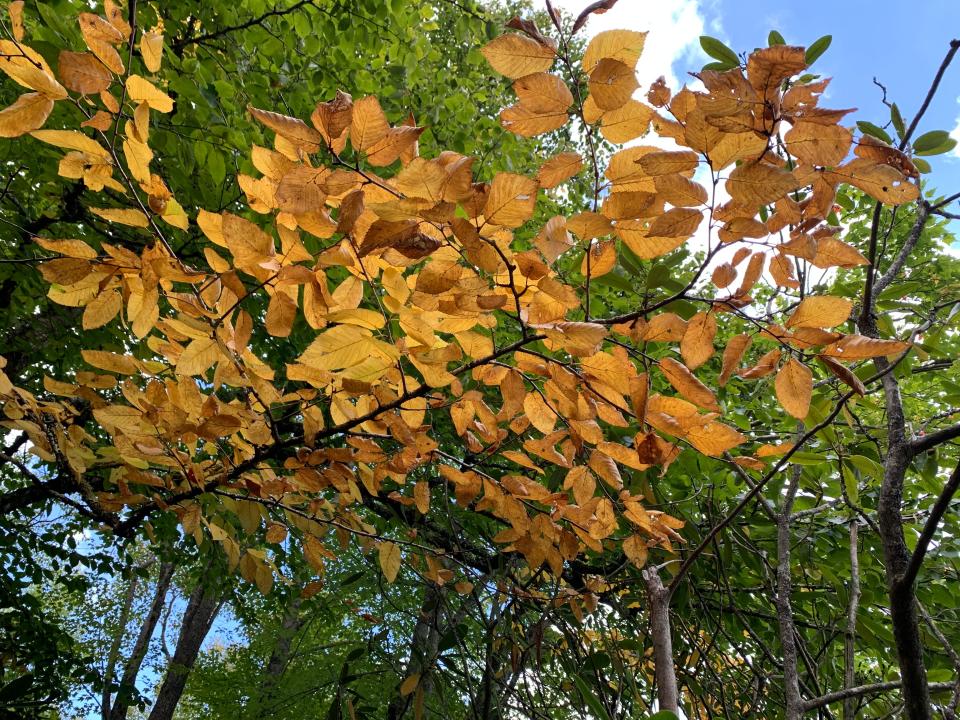Autumn leaves offer visual reminder in lessons of letting go | Candace McKibben
Having been recently in the mountains of North Carolina where I witnessed the beginning of the fall leaves changing color, I was reminded of a presentation that a friend and fellow chaplain, Paul Anway, and I made at a Bereavement Conference that Big Bend Hospice used to sponsor annually. We called the presentation “The Seasons of Grief,” and used the seasons of the year as a way to describe the grieving process. It was while working on that presentation years ago that I first remember thinking about the virtue of letting go.
The leaves changing color in the fall has to do with a cycle prompted by shorter, cooler days, slowing down photosynthesis and chlorophyll production in the leaves of deciduous trees. This reduction reveals yellow or orange pigment in the leaves which is usually masked by the abundance of chlorophyll. In the process, the tree is absorbing as much energy as possible from its leaves before prompting them to fall.

Deciduous trees have a process by which they encourage their leaves to fall. When the leaves form in the spring, they produce a layer of cells called the abscission layer, where the branch and stem meet. The word “abscission” is the word from which we derive the word “scissors.”
This layer of cells at the base of the leaf stem allows the energy from the leaves to pass into the branch and trunk to be stored during the spring and summer for survival in the winter. In autumn, with cooler temperatures and shorter days, the tree reduces its production of a hormone called auxin, which weakens the abscission layer. This, in turn, causes the bond between the leaf and the branch to weaken, the leaves to dangle, and in time to drop from the tree. While the wind may help in the final stages, it is the work of the tree and the leaf to finally let go.
Loss and lessons from the trees
I came across a lovely poem by May Sarton, a Belgian-American novelist, memoirist, and poet, that fit nicely with the fall season of grief we were considering at the bereavement conference years ago. Titled “Autumn Sonnets,” it speaks of letting go as trees let go, understanding that fall is the release, the consummation. It refers to standing treelike, unmoved before the change, losing what I lose, to keep what I can keep. It ends with “Love will endure, if I can let you go.”
In another of her writings, “Journal of a Solitude,” Sarton writes these profound words, “I think of the trees and how simply they let go, let fall the riches of a season, how without grief (it seems) they can let go and go deep into their roots for renewal and sleep. Imitate the trees. Learn to lose in order to recover and remember that nothing stays the same for long, not even pain, psychic pain. Sit it out. Let it all pass. Let it go.”
It is the season of my life, and perhaps of yours, where it feels too many people I love and admire are dying. I understand that as humans we all will die, but that understanding does not make it any easier to experience the grief that we all also experience. Learning ways to process our grief and let go of that which is precluding us from embracing life after loss, as we are able, is important.
Holding on to pain
Sometimes, for fear of “letting go,” we may find ourselves “holding on” to our pain as a way of remembering those we love and have lost. Letting go of what used to be is not an act of disloyalty, and it does not mean forgetting our loved ones who have died.
Letting go means leaving behind the sorrow and pain of grief and choosing to go on, taking with us those memories and experiences that enhance our ability to grow and expand our capacity for joy.
I was glad to be reminded of this long-ago presentation and to revisit these poetic words about letting go, not only in grief, but in many facets of our lives. I think of the ways in which my own theology has evolved through the years, involving letting go of certitude. I believe God works in subtle, mysterious ways, always and everywhere, to redeem us without violating our freedom.
But how God works is beyond my understanding, and letting the mystery be feels most congruent with faith to me.
Moving beyond a painful past
I think of a remarkable definition of forgiveness that I read years ago. While it is uncertain who first said it, the definition has been used by people ranging from writer, Anne Lamott, to comedian, Lily Tomlin. “Forgiveness is giving up all hope of a better past.”
Ministers do not usually counsel people to give up hope, but in this profound definition, letting go of hope for what you cannot change opens your heart to embrace redemption in the moment and going forward. Holding on to what could have been is crippling.
If our memories are painful and unpleasant, they can be hurtful and destructive. If they create longing and hold us to the past for whatever reason, they can interfere with our willingness to move forward. By letting go we have more space for the good in our spirits and in our lives.
Letting go is not only good for trees. It is healthy for us as humans. I have a vivid memory of young grandsons some 10 years ago, then at ages five and six, sitting on the couch watching Disney’s popular movie, “Frozen,” with arms linked and voices loud, belting out along with Queen Elsa, “Let it Go!” I pray it might be so for us all.

The Rev. Candace McKibben is an ordained minister and pastor of Tallahassee Fellowship.
This article originally appeared on Tallahassee Democrat: Fall offers lessons in grieving and letting go

